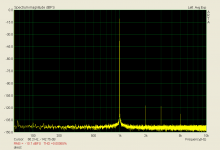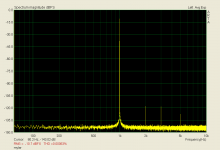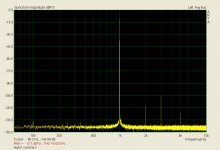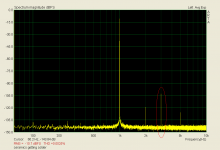You are creating your own world of hi-end sound reproduction, Frank
Pavel, isn't everyone?
If we can agree that each and every one of us hears things in his way, then ultimately every one of us has his own musical world. We establish "good" by majority vote.
A friend was listening to my setup powered by the Marantz 170DC power amp and commented that it lacked or missed out on sharp, fast sound, like cymbals being struck with some force. I disagreed, and replayed the track several times. but each kept his view.
Some months later, I went to his place and that track came up again. So we played it several times on his setup and he liked his version better, while I felt his CD player was not doing something right, as it sounded shrill to me, as if it was accenting the high range, say from 6 or 7 kHz upwards. On the other hand, his overall system balance was a bit too bright for me, and having had previous experience with German made Elac speakers like his, I suspect they also had something to do with it all.
So, who's right and who's wrong? It's a simple fact that we are both used to the sound of our systems, never mind how they might sound to someone else. To try to get to the bottom of it, we repated the experience at my place again, this time using H/K PA 2400 as the power source. This time, my friend was happier and said that was more like it. We lugged the amp to his place, and he now felt the high range was being exaggerated. I said that's your speakers' doing now.
So, what's the truth? Probably somewhere in between, as usual. It's true that the Marantz amp is a little too polite on occasion, but it doesn't miss a beat. The H/K is 3 dB more powerful, very low GNFB, but still very fast and very powerful, with an immediacy not often found in its price range and it's very load tolerant, I know this from experience, it will drive anything you care to call a speaker. Nevertheless, some people are bothered with that, others praise him for it, and in the end, it comes down to what we are used to and have come to accept as our own references, admit it or not.
So how is Frank wrong, when, after all, he does excatly what we all also do? He just goes about it in his own way, and, like all of us, does fall into a sticky situation now and then. True, again like most of us, he does go a bit off course, I never agreed with him that small PC speakers could ever hope to compete with "proper" speakers, but I do agree that some of those El Cheapo speakers can sometimes do better than we give them credit for (although still not like proper speakers).
As usual, missing the point, Pavel,Yes, youtube video compressed sound, music distorted by origin, it gives me an idea what you are looking for. You need a very specific system to mask all of those imperfections of the sound material you use for testing
The whole point being, that once one has used various such musical track tools to highlight problems, and then hopefully being able to resolve them - then one can enjoy a very wide array of recorded material, with no, I repeat, no, nasty surprises. May not be everyone's cup of tea, but is certainly mine
I am still puzzled by your attempt to distinguish between "charge/discharge" and audio use of capacitors. I can't think of anything in audio which uses the cap in some other way than charge and discharge. Is there something else you can do with a cap apart from changing the voltage across it by passing a current through it?
In a strict sense that's true, but for coupling, we're approaching the limit where the voltage change across the cap is zero. I suspect that in using terms like "charge" and "discharge", people are thinking of the opposite limit, i.e., deep charge and discharge in the manner of a timing cap. Yes, that's sloppy terminology, and I am probably guilty of that as well.
DA is, of course, highly relevant to the latter situation and irrelevant to the former.
Dejan, in my world that Marantz is flawed; the H/K sounds like it's on the money. I'm always after "correct" sound, which means only hearing the intrinsic sound of the recording, the playback system is completely removed from the picture. And that's what I always end with - now if you're concerned with separate PC speakers, then how about the internal speakers of a standard laptop, eh ...It's true that the Marantz amp is a little too polite on occasion, but it doesn't miss a beat. The H/K is 3 dB more powerful, very low GNFB, but still very fast and very powerful, with an immediacy not often found in its price range and it's very load tolerant, I know this from experience, it will drive anything you care to call a speaker. Nevertheless, some people are bothered with that, others praise him for it, and in the end, it comes down to what we are used to and have come to accept as our own references, admit it or not.
So how is Frank wrong, when, after all, he does excatly what we all also do? He just goes about it in his own way, and, like all of us, does fall into a sticky situation now and then. True, again like most of us, he does go a bit off course, I never agreed with him that small PC speakers could ever hope to compete with "proper" speakers, but I do agree that some of those El Cheapo speakers can sometimes do better than we give them credit for (although still not like proper speakers).
I have been quite surprised at how far the standard HP sound goes, obviously very low in volume, but within those limits also has high integrity - much, much better than the majority of the systems at the recent hifi show, for example.
OK, in an audio coupling cap we are not changing the voltage across it by not passing a current through it (well, nearly). Given a suitable cap value, any dielectric will do - even a high-k very non-linear ceramic! DA is irrelevant.SY said:In a strict sense that's true, but for coupling, we're approaching the limit where the voltage change across the cap is zero.
For deep charge/discharge DA is experimentally found to be linear. This seems to be the case however fast or slow you do it.
It is hard to see how a phenomenon which at one end is irrelevant and at the other end is linear suddenly develops significant non-linearity when we try gentle charge/discharge as in an audio filter application.
This give-me an idea. My next system will have a 3 position switch: "Impressive", "Transparent", "agreeable".YYou need a very specific system to mask all of those imperfections of the sound material you use for testing
OK, in an audio coupling cap we are not changing the voltage across it by not passing a current through it (well, nearly). Given a suitable cap value, any dielectric will do - even a high-k very non-linear ceramic!
You are oversimplifying and you are NOT right. Please see 3 measurements - direct, mylar cap 3.3u, high K ceramics 100nF, load is 24 kohm, input voltage is 1.55Vrms. Ceramics adds distortion, H3. Worse, the distortion is temperature dependent (highly). If you want for me to check 100nF mylar as well, I will, but I know it adds nothing.
Attachments
Sorry, I was exaggerating. In the real world coupling caps do carry a small signal current so do have a small voltage change, so dielectric nonlinearity can play a small part.PMA said:You are oversimplifying and you are NOT right.
I may happily use a ceramic coupling cap in a communications receiver, or even an ordinary broadcast AM receiver, but rest assured I would not do this in hi-fi!
Please see 3 measurements - direct, mylar cap 3.3u, high K ceramics 100nF, load is 24 kohm, input voltage is 1.55Vrms. Ceramics adds distortion, H3. Worse, the distortion is temperature dependent (highly).
Which case size and is the dielectric X7R, X5R or Z5U for the hi-K ceramic? 0.002% for 100nF into 24k presumably translates to 0.0002% for 1uF into the same load? Or are there other factors in play here?
Am I right in thinking that the plots show that even a spectacularly non-linear dielectric only produces small amounts of distortion in a coupling cap? So a reasonably linear dielectric can only produce extremely tiny amounts of distortion, far below that produced by active devices and transducers?
Am I right in thinking that the plots show that even a spectacularly non-linear dielectric only produces small amounts of distortion in a coupling cap? So a reasonably linear dielectric can only produce extremely tiny amounts of distortion, far below that produced by active devices and transducers?
Yes, we agree on this, my point is that we should not use the worst possible part just for the reason that it has probably "negligible effect".
a nice demonstration of what many of us have been saying: coupling caps just aren't that critical.
But the pleasure of knowing you removed one by adding a servo is known to make things sound better !
-105DB ? Ok, i think we can afford one (and only one) in a system. (In a servo, as example ;-)Ceramics adds distortion, H3. Worse, the distortion is temperature dependent (highly).
Yes....coupling caps just aren't that critical.
Last edited:
-105DB ? Ok, i think we can afford one (and only one) in a system.
The budgeted allowance appears to go up if they're put in parallel - increasing the capacitance reduces the signal voltage they see. So if one's allowed, then equally 4 (in two parallel pairs) or 9 (if we put them in triplets).
- Status
- Not open for further replies.
- Home
- Member Areas
- The Lounge
- John Curl's Blowtorch preamplifier part II



